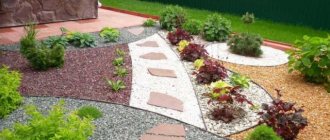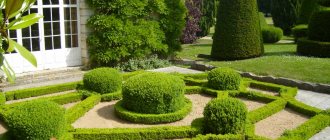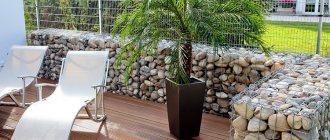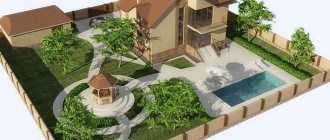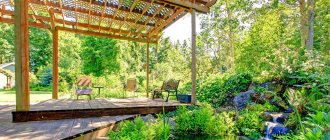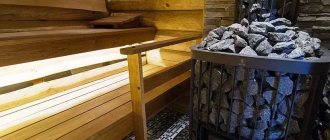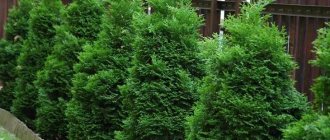Walking through the forest or along the riverbed, the eye catches the rock outcrops peeking out from the vegetation everywhere. And when we use boulders and natural stones of various sizes in our garden, we strive to create differences in height, structure and material that make up the charm of that very natural appearance. They visually improve the landscape of the site, flower beds and flower beds, both small and large. Boulder stone can act as an independent accent to create a focal point on your site, making its layout individual, interesting and multifaceted.
Features of the use of boulder stones in modern landscape design
Today on the Internet you can see many ideas for using stones in landscape design. But when we include this natural element in the decor of our garden, it is not always appropriate there. Either too small, or unreasonably large, or even completely, as if it accidentally fell there. To prevent this from happening, it is better to adhere to the rules dictated by modern landscape design:
Don't be afraid of big boulders. When you choose a boulder, it may seem huge for your garden. But in practice, against the backdrop of the design of the site, this impression will disappear, and the selected specimen will no longer correspond to the goal.
In nature, stones do not float above the ground; as a rule, only part of the rock is visible to our eyes. Therefore, you need to create the same effect at home. The shape and size of a particular boulder will indicate how deep it needs to be buried.
A lone boulder is unlikely to look out of place. Most often I place them in groups.
There should not be many different species on the site, otherwise it will lose its naturalness. It is best if the color and nature of the stone matches the area where you live.
The stones should look as if they have always been in the garden. Therefore, sometimes they need to be “aged”, for which the surface is decorated with moss.
Landscaping style must be considered to determine how boulders should be placed. If for English gardens these are dilapidated fragments of stone walls and a stone fence, then in Japanese gardens the blocks imitate mountains and should protrude upward.
When the garden is illuminated in the evening, the proper illumination of the boulders can convey drama, mystery, emotion, or leave room for imagination.
rocky flower garden
Landscape designers offer many ways to combine traditional plants and stones in a flower garden. Small pebbles can be used to fill individual parts of the site. This technique will be an excellent decor and background for planting.
- When and how to prune roses in autumn for winter: tips and step-by-step instructions
A decorative cart is a beautiful option for landscape decoration, see options and ideas on how to make a cart with your own hands (photos and videos)
- A beautiful decorative mill is a way to decorate your site in an original way without much effort, see how to make a mill with your own hands!
Materials used to make artificial boulders
Boulder stones for landscape design have an impressive weight and are not cheap. Since the price consists of the cost of the stone itself, loading, transportation and unloading. In addition, due to the large mass, it is not always possible to move the boulder to the desired place. In this case, they are replaced with artificial ones. For imitation of natural stone made of fiberglass and polystone, you will also have to pay a considerable amount. However, if you wish and have time, it is not at all difficult to create beauty with your own hands.
Papier-mâché and cardboard
The material can be anything: papier-mâché, cardboard, brown packaging paper, polyurethane foam, fine mesh, household waste (bags and plastic bottles), polystyrene foam.
There is probably no such person who would not make crafts from papier-mâché during labor lessons at school. Therefore, the technique is familiar and simple. Take a form, for example a cardboard box, and paste it with strips of newspaper using flour paste. Due to its light weight, this craft can be any size. The finished product is left to dry completely, after which it is covered with aerosol paints.
Instead of cardboard, you can use thick packaging paper. In addition, with its help it is easier to set the desired shape for the future boulder.
Styrofoam
This material is even easier to work with. There is no need to waste time drying each layer of paper.
From a piece of foam plastic, using a construction or electric knife, any shape is cut out, which is limited only by your imagination. After which it is covered with a solution of 3-4 layers, prepared from one part cement and three parts sand. For better elasticity, add a little liquid soap to it. Each subsequent layer is applied after the previous one has completely dried.
With polyurethane foam the result will be the same.
Fine mesh
You can collect construction waste: pieces of plaster, broken bricks, etc., and wrap them with metal mesh. Then, as in the previous case, layer by layer is covered with concrete mortar.
Household waste
Every home accumulates a large number of plastic bags and plastic bottles, which can be disposed of in an unusual way. To do this, just take a garbage bag the size of the future boulder, put the trash in it and give it the desired shape. Then secure everything with wire, which is best wound in different planes. Now you will need old and unnecessary bed linen, shirts, etc. They should be ripped open in advance, freed from seams and torn into small pieces. Next, a liquid cement mortar is prepared (from cement and water), into which the prepared fabric is dipped and applied to the mold, according to the papier-mâché principle, in several layers.
To make homemade boulders look realistic, various techniques are used.
Using a spatula, create dips and folds when the solution has not yet set.
To obtain a more porous structure, replace 1 part sand with peat moss (sphagnum) and make a solution as follows: 2 parts sand, part cement and part moss.
To create a rough surface, use an abrasive sponge or wire brush.
To give it a wrinkled appearance, pass over the stone with a crumpled plastic bag.
To avoid cracking, finished products are dried in the shade. After complete drying, coat with three layers of water-based concrete primer. Then acrylic exterior paint is applied with a sponge. If desired, the products are varnished.
With a creative approach to the process, you can create fantastically beautiful boulders for your garden with your own hands, which in texture will look like natural ones.
Limestone (shell rock): studying the advantages
Airy, porous, but quite durable stone interspersed with the remains of biological organisms is suitable for the construction of wall structures of light buildings (gazebos, belvederes, arches, pseudo-antique ruins), and cladding of solid buildings. To increase its service life, it is recommended to treat it with water-repellent compounds.
The color of limestone adds warmth to the atmosphere of country life. Shell rock is used to create garden furniture (benches, deck chairs), and to erect barrier walls separating the garden from the main space. A fence like this looks like a picture from a glossy gardening magazine and has 2 big advantages:
- the area of garden plants warms up better, the walls protect from the effects of winds;
- During natural weathering, the rock enriches the earth with calcium compounds, which are transferred to the “garden dwellers.”
Appearance of boulders and features of choosing a specific model. Wide range of shades
A great way to improve and enhance not only the style of the site, but its functionality and comfort, is to use stones, a variety of types and in various techniques.
Before considering the options, let's define the concept.
A boulder is a piece of rock that has been polished by water flows and carried by glaciers. The size can vary from 10 cm to 10 m. Smaller fractions, rounded and smoothed with water, are called: pebble, pellet, round, cobblestone (10-30 cm), pebbles (1-10 cm in diameter). Sand and screenings (less than 5 mm) are widely used. Roundness has a different genesis; it can be associated with the polishing of the rapid water mass of mountain streams during transportation.
An unrounded rock fragment with sharp corners is called a block.
The size of the site or technical capabilities do not always allow placing a block or large boulder; then you need to pay attention to irregularly shaped rock fragments, the diameter of which along the long axes is over 100 mm (small boulder).
All of the listed sizes of stones are used in landscape design for various purposes: paving, borders and fences, retaining walls, rock garden, rock garden, stair steps, garden furniture, etc.
The purpose of a natural stone is determined by the type of rock and the processing technique that allows you to reveal its true beauty. Of course, a certain processing of the sharp edges of boulders and blocks can be acquired through aeolian activity, but this is often not enough. Additionally, techniques such as polishing, grinding, chipping, sawing, “scratched surface”, aging and heat treatment are used.
When it comes to choosing the type of material, the market today offers many available options. But the wider the choice, the more difficult it is to make it. To understand how stones will cope with their assigned role and combine with style and surroundings, you need to know their structure and origin. Let's look at three types of rocks that differ in petrographic composition:
Volcanic rock boulders have a strong base and heavy weight, making them suitable for solving most problems. Presented in a wide range of colors and shades, they look very picturesque, both in their original form and after processing. This group includes granite, light felsite and dark basalt, dunite in light and dark green tones.
Sedimentary rock stones are characterized by a layered porous structure, do not withstand impact well, and have low abrasion rates. However, they are easy to process, and the variety of colors and types allows them to be used in decoration, landscape design and construction. First of all, these include tuff, shell rock, sandstone and dolomite.
Shungite, marble and slate are metamorphic rocks. If we talk about their origin, they have a sedimentary nature and a layered structure. Unlike the second type, they are distinguished by higher strength. A variety of colors, from light gray to black, allows you to create an individual and interesting design.
Now all that remains is to make a choice and decide on the destination.
Sandstone - light, beautiful, smooth
Sandstone makes it possible to obtain flat slabs of the required thickness with torn edges; it is widely used to create garden paths, finish the basement of a house, and frame the contours of raised flower beds, creating the desired height.
If the sandstone slabs are not held together with mortar, then the inside of the flowerbed is duplicated with dense geotextiles to prevent the fertile soil from being washed out through the cracks during watering.
When filling the bed of a garden path, geometrically correct sandstone tiles allow you to leave minimal gaps. It is optimal as a material for the construction of retaining walls: a flat surface makes laying easier. Flat faces can be adjusted to each other so well that the “dry masonry” method is sometimes used, excluding binder mixtures. Slabs of reduced thickness are successfully suitable for decorating vertical surfaces and cladding small architectural forms.
Ideas for using stone in the garden
If you're looking for an easy way to transform your garden and make it special, rocks are the way to go.
Create an alpine slide with your own hands
This could be a composition in the highlands, when large stones are buried 2/3 into the soil. Or a rocky cliff with dwarf fern, mountain pine and juniper. And when there are different heights in the garden, it is enough to surround the hills with large boulders.
Create a rock garden - a luxurious stone flower garden
The rock garden should look natural and fit organically into the surrounding landscape. When choosing plants, be sure to consider the size of the stone. They should have an interesting shape. Boulders from your region are best suited for these purposes.
Lay out a path of stones at your dacha
There is something about a path made of stone that immediately brings to mind images of an English garden. Especially if they are combined with neatly trimmed hedges, lush flower beds and narrow intimate paths.
Make a simple and effective flower bed with boulders
Before making a flowerbed with boulders, do not be lazy and draw a plan for the future composition. It is easier to come up with several options for placing stones while sitting in a comfortable chair than to drag heavy boulders from place to place.
Rock garden
A beautifully designed garden can decorate the look of any home, and if its exterior is decorated with rocks and boulders, this will give it a natural look.
You can create a pond with stones and surround it with boulders
Boulders sticking half out of the water look very aesthetically pleasing. The picture will be even more picturesque if they are covered with moss. But along the banks you should not lay out boulders in a continuous line. It is better if they are broken up by plants and sand.
Build a waterfall on the site
A waterfall in the garden is a beautiful decoration and does not require much space. It is enough to take two large boulders and install a hose between them to drain the water.
Decorate your garden with a dry stream of stones
A dry stream is a decorative element of the garden, which can be a continuation of a pond with a stone cascade. However, do not overdo it with its size, otherwise you risk reducing the “naturalness” of the garden.
Decorate your flower beds with stone borders
Borders made of natural untreated stone with colorful vegetation will create the illusion of a mountainous area in your garden.
Create platforms from stones
The stone is equally well suited for creating paths and large areas, from which garden paths made of small pebbles diverge in different directions.
Decorative fills
Such fills perform two functions: practical and aesthetic. Weeds do not grow under them and the soil does not dry out. They are especially irreplaceable when creating rockeries and mixborders.
Use rocks as mulch
Stones are a durable mulching material that heats up during the day and releases heat at night. To prevent the root system of plants from overheating, it is better to use light-colored stones as mulch in sunny areas.
Retaining walls
A stone retaining wall is a beautiful, practical and important addition to your landscaping. For their construction, flat stones and stone blocks are used.
Ruins
The romance of an abandoned garden will not leave anyone indifferent. The ruins can serve as magnificent decorations for flower beds or a spectacular shield for a recreation area. The technology of artificial aging of stone will come in handy here.
Fireplace
A fireplace in the garden is an incomparable pleasure, sitting with friends and family, listening to stories, eating baked potatoes and inhaling the aroma of smoky meat. And the easiest way to make it is from stone and brick.
Make stylish gabions from stones
Modern gabions are mesh frames made of steel, tightly packed with crushed stone, gravel, and stones of various types. They look stylish and beautiful throughout the year.
Figures and paintings
Beautiful compositions of large stones with paintings can become an amazing garden decor and its bright spot.
The highlight of stone figurines is their natural beauty. And the simpler they are, the more natural they look.
Decorate the banks of the pond with stones
The decor of your garden pond, banks, bottom and fish shelters can be made of gravel or various stones. Gravel is ideal for the bottom of a pond; with an average pebble size of 10 to 40 mm. It creates a surface that is very conducive to the breeding of aquatic insects. These insects are useful in maintaining the balance of the pond ecosystem by feeding on microorganisms. Pebbles also help provide fertile soil for aquatic plants to have a solid base for their roots.
Medium-sized stones throughout the pond, along the edges or at the bottom, mixed with gravel, are ideal for these conditions and further facilitate plant anchorage. Available in different colors, these accessories will easily create a harmonious atmosphere. Besides adding a touch of nature's naturalism to the landscape (used in a waterfall, stream, etc.), they can also hide a filtration system or make excellent hiding spots for fish.
Decorative pebbles for the garden
In recent years, pebbles have become an indispensable element in garden decor. This is facilitated by low cost, durability, ease of maintenance and a large scope of application.
Planting
First, decide what types of plants are suitable for the rock garden. Take your time with landing. To get the desired result, place pots with plants throughout the rockery. Choose the right species that will fit well and will be combined in shape, color, size, texture of leaves and needles, with each other.
Plant alpine plants in spaces between stones for landscaping. Place miniature shrubs among the blocks; be sure to consider how much they will grow in the future.
Fill rocky voids with low-nutrient soil:
- sand,
- Earth,
- fine crushed stone in a ratio of 3:2:1.
Consider what kind of soil different types of plants prefer, acidic, alkaline, neutral. Only then fill the planting areas with suitable soil.
You can easily select the necessary plants for a rock garden and natural landscape stone in garden centers or nurseries. There is no need to rush, first study the characteristics of the species, and only then purchase.
What should be the outcome?
Considering that the plants in the rock garden are small in size, it is necessary to provide an acceptable view from different angles. Hosts and guests should be able to easily admire and appreciate the views. Decorative stones for landscape design, see our photo gallery:
Care and maintenance
Natural stone does not require special care. It is enough to remove fallen leaves, remove weeds and clear away dirt. To make maintenance easier, it is important to choose the right type of stone. For example, white marble looks very beautiful in the garden, but quickly loses color and is susceptible to rotting. Whereas a granite boulder is resistant to moss and mold.
Formations on stones can be removed without problems with acid solutions, but not all rocks can withstand their impact. The instructions usually indicate such information.
painting
The easiest way is to paint garden stones. Children can be involved. The result will be fun and bright. Use of abstraction, graphics or other motifs: the choice is individual.
Some people imitate rock paintings, others paint real pictures. Don't be afraid to create. In any case, the results of independent work are pleasing.
Construction of reservoirs, cascades, streams
Stones can be used for filling or paving the bottom and walls of a reservoir (fountain, lake, pool, pond). If there is a stream with running water on the site, its bed can be lined with pebbles or small cobblestones. Another design option is to create a cascade or imitate a mountain stream with a bed of large boulders or rocks (possibly with a large difference in elevation on the site). If the pond will be used for swimming, it is better to fill the bottom with small round pebbles. Large cobblestones can be used to decorate the coastal zone.
Stone jewelry made easy!
A good solution to avoid the above-mentioned difficulties is to replace natural rocks with polystone stones. This is a material based on acrylic resins and aluminum hydroxide, which combines the beauty of natural stone and the capabilities of modern composite materials.
Decorative stone for the garden Decorative stone-pots for the garden Decorative stone for the garden
Polystone is non-toxic and therefore absolutely harmless to both people and animals. This means you can safely decorate the summer cottage where you plan to relax with your children and play ball with your dog with polystone boulders.
In addition, polystone is a fairly light material, and therefore creates fewer difficulties during transportation and installation on site. This property is especially noticeable when it comes to boulders intended to mask communications. The covers of manholes and septic tanks made of polystone, imitating natural stone, are hollow inside and equipped with ventilation holes, which greatly simplifies installation and operation. Even the largest manhole covers, up to 2 m in diameter, remain lightweight due to the hollow design and material characteristics.
Another advantage of polystone stones is their resistance to external influences. Polystone does not react with air, it is not afraid of ultraviolet radiation and high temperatures - the material can withstand heating up to 180 degrees. In addition, products made from polystone are easy to clean, they do not stain, for example, from fruit juices - so the decor of your garden will last a long time, even if you have picnics in your “stone” garden every weekend.
Decorative cover for a hatch Decorative cover for a hatch Decorative cover for a hatch
In addition, polystone easily withstands moisture, which is especially important when masking communications where contact with a humid environment is possible. However, this property of the material is also useful for purely decorative polystone products, which can be safely left in the garden in bad weather - they are not afraid of snow and rain.
Finally, polystone will easily fit into any design plan, since this material can have up to a hundred different colors - which means you are not limited in your choice by anything other than your imagination. You may prefer to imitate natural stone - for example, sandstone, granite, or any other. Or you can give free rein to your imagination and turn your garden into a truly magical corner, populated with charming fairy-tale figures.
Garden figure Deer
Fountain and washbasin Boulders Figure for the garden Gnome on a stump
But it is important to understand that the material is, first of all, a tool for realizing your plan. And no matter what you decide to create on your site - an elegant decoration for a flower bed, an elegant and neat camouflage for household structures, or an entire stone garden for meditation - boulders will give your garden originality and a touch of the eternity and tranquility of stone.
Paving
Natural stone is used to construct paths and platforms. It can be paving stones, hewn cobblestones, flagstone, crushed stone. Paving is carried out on poured and compacted sand, observing a certain layout. Flagstone can be laid on a concrete base using construction adhesive and jointing. For paving walkways, parking areas, and recreation areas, it is better to choose stones or slabs with a non-slip, but smooth, not too embossed surface.
Facing
Flagstone and crushed stone can be used as facing material when constructing plinths, columns, retaining walls, parapets, fences and other structures. The cladding is carried out on a solid base using special glue. It is better to plan its “drawing” in advance by arranging the stone elements in the order in which they will be glued to the wall. You can cover any surface, including the bowls of reservoirs and fountains, their outer walls, containers, flowerpots, containers for plants, and stair steps.
